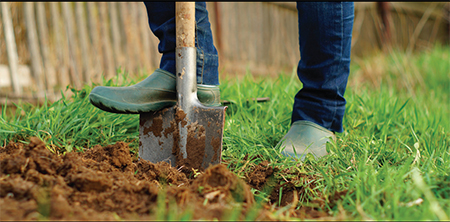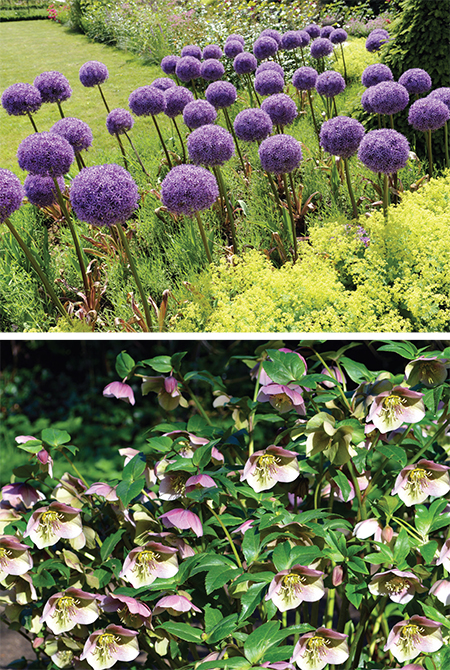Now is the time to start fantasizing about the possibilities that the warmth of spring will bring.
The senses become alive with the increased amount of sunshine, the sweet song of birds migrating north, warm breezes greeting us from the south, and the bumblebees buzzing from one fragrant flower to the next.
Your garden can become a mecca for all the life that spring will bring. It’s a great time to get your hands into the earth and support the ecosystem that you call home.
For most people this can be overwhelming. First, I am going to give you a few design tips and permaculture techniques to apply.
Then I will go over some basic perennials and shrubs that provide early spring color and food sources for our friends—the butterflies, bees, and birds.
I am also going to only recommend deer-resistant varieties, since that’s an issue for so many of us.

garden location
As far as design is concerned, it’s important to look at your home and the land that surrounds it as one interactive space. This may feel challenging at first, but once you start to consider the flow of your life, it will become easier. As you move through your surroundings, think about what colors, textures, and shapes you want to see. It’s also important to consider where a pause is in order; this creates a space for something special—a highly fragrant shrub or a grouping for your favorite perennials. These are the building blocks for creating a design that suits your lifestyle.
To further this study in applying permaculture techniques, you would start by observing the natural state of the land and what is currently growing there, where the sun hits during the different seasons and the natural flow of the water after it rains. This information will help to determine if your location will require plants that prefer sun or shade, alkaline or base soil, and moist or dry conditions. It will also help to determine if your plan of use in this area is actually appropriate. While permaculture is generally applied to design for a larger scale system of living that integrates land, resources, people and the environment through mutually beneficial synergies, these principles can and should be utilized with even the smallest details.
trees and shrubs for spring color
Once you decide on a location, you want to start with the more prominent elements, such as trees and shrubs. For early spring color, I recommend the FLOWERING QUINCE, Chaenomeles speciosa 'Scarlet Storm'. With deep red double flowers and growing to a height of four to five feet, this shrub provides structure in the garden and is drought-tolerant once established. For a more muted pallet, one of the earliest blooming SPIRAEAS, S. prunifolia 'Plena', reaching four to eight feet, offers a romantic charm with clusters of double white flowers along arching stems. Other recommendations include the native EASTERN REDBUD TREE, Cercis canadensis, with small purple pea-like blooms emerging before the leaves, or the mysterious WHITE FORSYTHIA, Abeliophyllum distichum, blooming in late-March with profuse, axillary clusters of white, slightly fragrant flowers which open from purple buds.

But, it is important that you don’t forget an evergreen element. Even in spring the deep greens of the JAPANESE ANDROMEDA, Pieris japonica ‘Purity’, or the BOXWOOD, Buxus microphylla japonica 'Winter Gem', provide a resting spot for your eye and a backdrop for the amazing colors in the spring garden.
springtime perennials
Now that we’ve got the trees and shrubs covered we can move on to perennials. Generally speaking, it’s important to plant in repeat groupings. This creates a feeling of unity as opposed to the chaos of planting only one or two of any given variety. In order to create impact, and depending on the area you intend to cover, it’s best to plant in groups of three or five. You also want to have repeat groupings throughout the garden. When thinking about this, ideally, you would choose perennials that would either compliment each other while blooming at the same time or have bloom times that are staggered throughout the growing season. Since we are concentrating on the spring garden, I am going to recommend some particularly weather-tolerant varieties that will work for either shade or sun. Again, all of my recommendations will be deer-resistant and pollinator-friendly.
Generally speaking, it’s important to plant in repeat groupings. This creates a feeling of unity as opposed to the chaos of planting only one or two of any given variety.
With so many perennials to choose from, I am going to highlight some of the most impactful and hardy. One of the earliest and longest bloomers is the LENTEN ROSE, Helleborus orientalis. This perennial will bloom from March to May and comes in a myriad of colors. With its evergreen foliage, the hellebore adds four-season interest to any garden.


Your garden can become a mecca for all the life that spring will bring.
Another great choice for a spring planting is COLUMBINE, Aquilegia canadensis. Columbine is a beautiful woodland native that has intricate red and yellow bell-like flowers. This variety is especially attractive for pollinators—hummingbirds, butterflies, and bees—as it is an early season nectar source from May through June. Other important perennials for this time of year include LADY’S MANTLE (Alchemilla mollis), BLEEDING HEART (Lamprocapnos spectabilis), and BARRENWORT (Epimedium grandiflorum). Lady’s mantle adds excellent texture to the garden with its scallop-edged, light green leaves and loose, spreading clusters of chartreuse, star-shaped flowers. The bleeding heart ‘Alba’
is one of my personal favorites. This plant grows quickly in spring with large fleshy stems of lobed, light green leaves. The white, heart-shaped flowers dangle beneath arching leafless stems. These racemes are excellent cut flowers, lasting up to two weeks in a vase. And, lastly, barrenwort (commonly referred to as Epimedium): An especially good variety, ‘Lilafee’, has small lilac flowers that hang on dainty inflorescences. The compound foliage emerges after the flowers and looks good well into the fall. Over time, this plant will grow into a low-maintenance groundcover. This perennial prefers dry shade beneath shallow-rooted trees, thriving where many plants cannot.

bulbs
Last, but not least, are fall-planted bulbs, a staple of the spring garden. Since the window for fall planting has obviously passed, I am going to touch quickly on just a few varieties and some tips to get you thinking about plans for later in the year. DAFFODILS, depending on the variety, will bloom from March to May. They should be planted in clusters of five to nine and look best when repeat groupings create masses throughout the garden, lawn, and woodland
areas. A favorite of mine is the late-blooming NARCISSUS ‘THALIA’, a fragrant, pure white triandrus daffodil. Other recommended varieties include the ALLIUM ‘GLADIATOR’, growing three to four feet tall with large, globe-shaped heads of fragrant, lavender-blue florets. Or Muscari armeniacum, the GRAPE HYACINTH, whose cobalt-blue spikes naturalize throughout the garden from one season to the next.
It’s been a pleasure to visit the spring garden with you! If you are interested in knowing more, please contact me, Aja Hudson, Executive Director and Head Designer at the Earth Designs Cooperative, 845-658-7077 or visit our website at YourEarthDesigns.com

